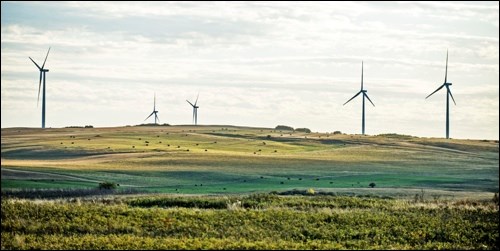On the way back from the Lloydminster Heavy Oil Show Sept. 14-15, I took a highway that had always intrigued me, but never had the opportunity to travel.
Highway 17 is unique in that it has signs indicating it is both an Alberta and Saskatchewan highway. Heading south from Lloydminster, it’s right on the border before skirting to the Alberta side for a bit, then crossing over to the Saskatchewan side. The first half hour or so of driving is dominated by heavy-oil batteries on both sides of the road. These eventually peter out.
It’s where the highway crosses back into Saskatchewan again where the energy infrastructure gets interesting. There, on the horizon, are numerous white wind turbines. A few are so close to the border, I wondered if they cut into Saskatchewan airspace as they turn. Apparently it was windy enough on the Alberta side to develop this wind farm, but for whatever reason, the political border might have been a wall.
It’s with this in mind that my email on Sept. 19 brought up something you don’t hear every day. A wind farm proposed near Chaplin had been denied approval.
The Saskatchewan Ministry of Environment press release read, “Environment Minister Scott Moe announced a wind energy project near Chaplin will not be approved to proceed in its proposed location. This decision was made after completing an environmental assessment process that included feedback from environmental non-government organizations (NGOs) and the public.
“The environmental review for the proposed project near Chaplin identified environmental impacts of concern to the ministry, the primary concern relating to migratory bird activity in the area close to the site. The ministry received 137 responses during the public review process in 2015. All but one of these responses supported wind energy, but expressed concern over the development’s specific location.”
It added, “Algonquin Power had proposed to build the 177-megawatt wind-power facility on behalf of SaskPower, which would have included a maximum of 79 wind turbine generators, approximately 50 to 70 kilometres of access roads and 110 kilometres of trenched transmission lines.”
But the most interesting thing is the statement, “This was the first wind electricity project to undergo an environmental impact assessment.”
What? Where’s the rubber stamp? I thought only the oil industry was evil! At least, that’s the message I get every time I turn on the TV. Pipeline, bad! Wind turbines, good! Heck, on the same day, no one less than David Suzuki spoke in Regina and Saskatoon to lecture us on the environment.
A few years ago some ducks died in a tailings pond near Fort McMurray and the world went nuts. But how many protesters paint signs about the birds and bats that are whacked each day by the swooshing blades of wind turbines?
It appears that was a concern here. The province announced new site guidelines for wind farms. A related announcement on the same day said, “A five-kilometre buffer zone has been established around designated environmentally sensitive avoidance areas such as national and provincial parks, ecological reserves, important bird areas and key Saskatchewan rivers. In addition, proponents will still be required to evaluate wind energy project sites at areas outside of avoidance zones to ensure any potential environmental and wildlife impacts are still mitigated. The guidelines were developed with industry and environmental stakeholders.”
I wonder how many birds will die in Alberta as that province moves to replace its coal power generation, to a large extent, with wind turbines?
This denial is a tacit acknowledgement that wind turbines kill birds. Locating turbines away from “sensitive areas,” might lessen the impact, but I’ve yet to meet a bird that cares about what is defined on a map. They fly where they want to fly.
I’m eagerly anticipating the protestors driving from across the country to picket the next wind turbine installation. Perhaps some, like at least one Ford Explorer driver on their way to pipeline protests in North Dakota, will run out of gas, while their windows are scrawled with “Oil spill oil kills!”
Turns out windmills kill, too, otherwise there would be no problem putting them anywhere you damned well pleased.
The difference is, pipelines only kill wildlife when something goes horribly wrong — the North Saskatchewan River spill this past summer for example. Wind turbines, on the other hand, kill birds on a regular basis throughout their entire existence.
Where are the protesters for that?
— Brian Zinchuk is editor of Pipeline News. He can be reached at brian.zinchuk@sasktel.net.



